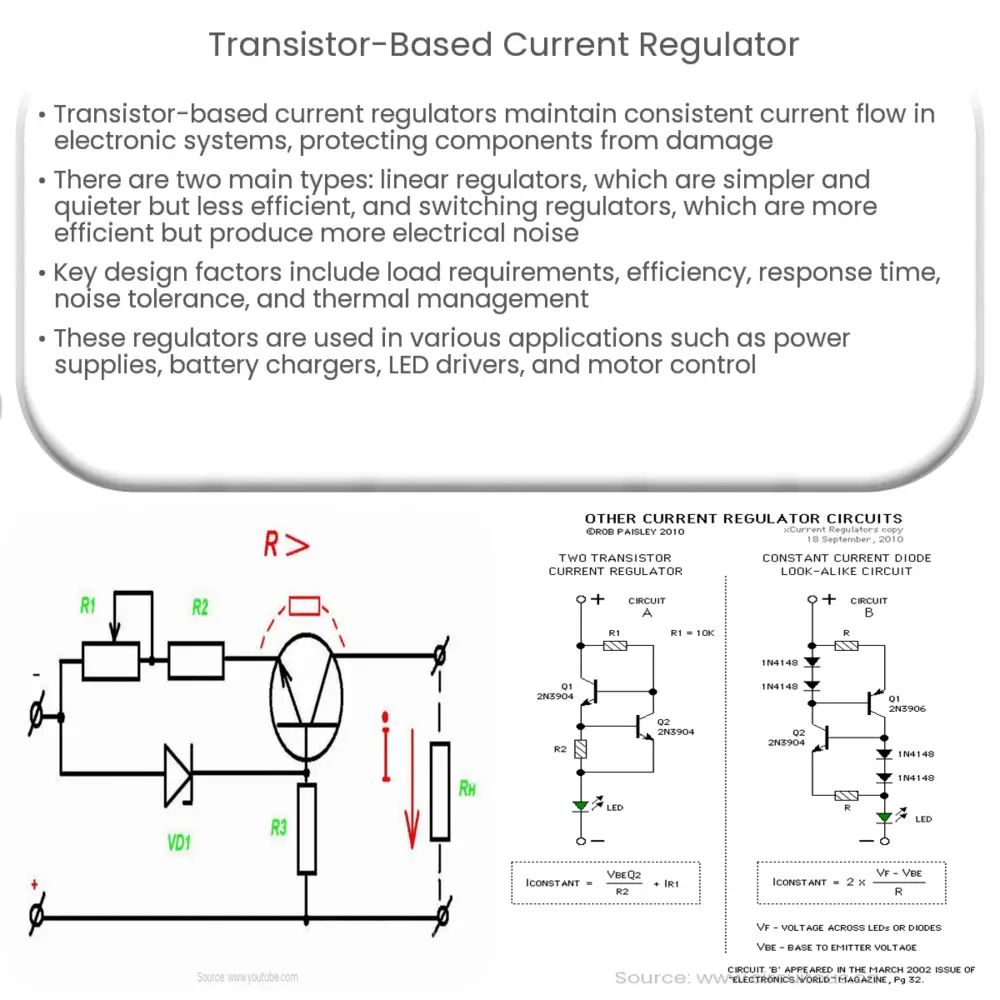Transistor-based current regulators maintain consistent current flow in electronic circuits, ensuring stability and protecting components.

Transistor-based Current Regulators: An Overview
Introduction
In the world of electronics, the transistor has long been a critical component in designing and constructing circuits. As a versatile and widely used device, it can be employed for numerous applications. One such application is the transistor-based current regulator, which plays a vital role in ensuring the stability and reliability of electronic systems. In this article, we will delve into the fundamentals of transistor-based current regulators, their types, and their importance in electronic circuits.
What is a Transistor-based Current Regulator?
A transistor-based current regulator is a circuit that uses transistors to maintain a consistent current flow, regardless of fluctuations in input voltage or load resistance. This is achieved by continuously adjusting the resistance of the transistor to keep the current at a desired level. These regulators are essential in many electronic systems, as they prevent current surges that could potentially damage components or lead to unstable system performance.
Types of Transistor-based Current Regulators
There are two primary types of transistor-based current regulators: linear regulators and switching regulators.
1. Linear Regulators
Linear regulators are the most common type of transistor-based current regulators. They use a feedback mechanism to monitor the output current and adjust the resistance of the transistor accordingly. Linear regulators offer several advantages, such as simplicity, low output noise, and fast response times. However, they can be less efficient than switching regulators, as they dissipate excess power as heat.
2. Switching Regulators
Switching regulators, also known as switched-mode power supplies (SMPS), are another type of transistor-based current regulator. They work by rapidly switching the transistor on and off, controlling the output current through pulse-width modulation (PWM). The duty cycle of the PWM signal determines the output current. Switching regulators are generally more efficient than linear regulators, as they do not dissipate excess power as heat. However, they can generate more electrical noise and have slower response times compared to linear regulators.
Components of a Transistor-based Current Regulator Circuit
Transistor-based current regulator circuits typically consist of several key components:
- Transistor: The main component responsible for regulating the current flow. This can be a bipolar junction transistor (BJT) or a field-effect transistor (FET).
- Resistor: Used to set the reference current or voltage, which determines the desired output current.
- Feedback mechanism: A circuit that compares the output current with the reference current or voltage and adjusts the transistor’s resistance to maintain the desired output current.
Design Considerations for Transistor-based Current Regulators
When designing a transistor-based current regulator, several factors should be taken into account to optimize the circuit’s performance:
- Load requirements: It is essential to consider the current and voltage requirements of the load to ensure that the regulator provides adequate power without causing damage or instability.
- Efficiency: Depending on the application, it may be necessary to prioritize efficiency to reduce heat generation and power consumption. In such cases, a switching regulator may be the preferred choice.
- Response time: Some applications may require a fast response time to maintain stability, making linear regulators a more suitable option.
- Noise tolerance: Noise-sensitive applications, such as audio or precision measurement circuits, may benefit from the lower noise levels produced by linear regulators.
- Thermal management: Proper thermal management is crucial, particularly for linear regulators, which can dissipate significant heat. Adequate heat sinking and ventilation should be provided to prevent overheating and maintain reliable operation.
Applications of Transistor-based Current Regulators
Transistor-based current regulators find their applications in a wide range of electronic systems, including:
- Power supplies: Current regulators are commonly used in power supplies to ensure stable and reliable output currents, protecting both the supply and the connected devices.
- Battery chargers: In battery charging circuits, current regulators help maintain a constant charging current, ensuring efficient and safe battery charging.
- LED drivers: LED lighting circuits often employ current regulators to maintain consistent brightness and prevent damage to the LEDs due to current surges.
- Motor control: Current regulators can be used to control the current supplied to electric motors, enabling precise speed and torque control.
Conclusion
Transistor-based current regulators play a crucial role in maintaining the stability and reliability of electronic systems by ensuring a consistent current flow. With a variety of design considerations and applications, these regulators are a fundamental component in the world of electronics. As technology continues to advance, further improvements in efficiency, response time, and noise reduction can be expected, broadening the possibilities for their use in future electronic systems.



